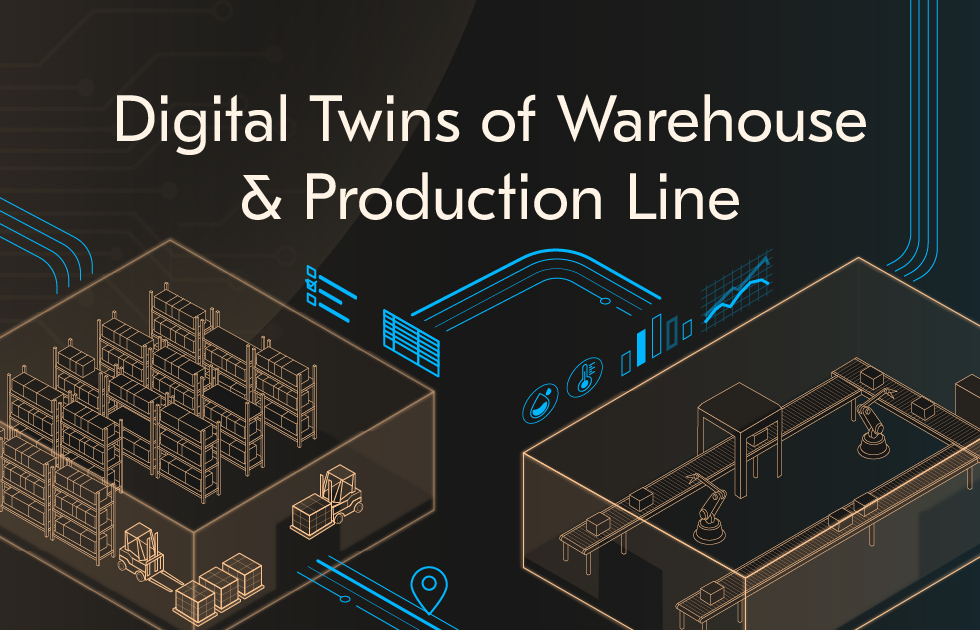

- Big Data
- Custom Software Development
- Data Analytics
- AI & ML
- Real-Time Solution
- Reporting
- IoT
We develop cutting-edge supply chain analytics software featuring AI-driven predictive ETAs, machine learning capabilities, and complete real time visibility throughout logistics operations. Our supply chain analytics platform delivers control tower functionality, demand forecasting tools, smart route optimisation, and anomaly detection systems. Learn how centralized data revolutionizes supply chain effectiveness.
client
NDA Protected
Germany
80 employees
Our customer is a leading third party logistics (3PL) provider offering freight forwarding, warehousing, and distribution services, and integrated supply chain analytics software. The company conducts warehousing, distribution, and transportation operations throughout Europe, requiring sophisticated supply chain analytics software with integrated control tower capabilities.
request background
Supply Chain Analysis Tool Development for Better Process Efficiency
The customer was in desperate need to optimize supply chain efficiencies with systems that could be better-managed from a central core. Industry standards changed with rapid globalization, technological advances, and changing customer desires, making actionable data a must from a supply chain analytics platform to stay competitive.
These days, customers demand personalized services that meet their specific requirements, fast delivery, transportation in climate-controlled conditions, or exact just-in-time arrival, for example. By using supply chain analytics software with advanced demand forecasting capabilities and behavioral insights, the logistics service provider could more precisely tailor services to satisfy customers and generate greater brand loyalty.
Equally important was streamlining logistics through inventory optimisation and smart route optimisation. The organization required performance indicator assessment, system upgrades, and what if scenarios capability to reduce delivery timeframes and lower operational expenses.
Understanding big data's potential and real time visibility benefits, the client partnered with our development experts to build a complete supply chain analytics system featuring unified control tower functions.
challenge
Challenges We Overcame in Supply Chain Predictive Analytics Case Study
This prominent 3PL provider encountered major obstacles managing and utilizing scattered supply chain data throughout their broad operational infrastructure.
Their primary difficulty involved handling enormous data volumes spread across different platforms, from ERP systems and IoT sensors ERP GPS integration points, to telematics hardware, warehouse systems, and third-party databases. Such data separation blocked unified real time visibility and effective control tower implementation.
Data isolation prevented a complete operational understanding. Without centralized supply chain analytics software, they couldn't recognize patterns, run what if scenarios, improve processes, or make timely strategic decisions. Missing predictive ETAs features meant struggling with delivery promises and customer updates.
Fragmentation hurts specialized processes, too. Without persona based views, executives accessing the COO dashboard received identical data as staff using the logistics manager dashboard, causing information excess and inefficient decision-making. Manual compliance and reporting tasks drained resources while increasing audit exposure.
With sensitive data being transmitted between multiple systems and networks, the company was continuously at risk for information loss, hacking, and break-ins. An increasing number of regulatory requirements applicable to data governance, which made it harder to comply with GDPR and separate industry standards.
It was crucial for the business to have robust security, encrypted levels of data encryption running across all three countries, and access management, as well as extensive data governance measures in place with a centralised solution protecting sensitive information at every touchpoint.
No proactive problem identification because of lack of good anomaly detection. Lacking advanced demand forecasting and inventory optimisation, they suffered from out-of-stocks, overstock and underutilised warehouses.
Outdated systems and manual methods reduced flexibility. Addressing these issues, the client committed to complete supply chain analytics software creation, needing sophisticated analytics, predictive algorithms, route optimisation systems, and automation for real time visibility and tracking.
goals
- Unite and combine data from scattered platforms using complete IoT sensors ERP GPS integration, bringing together ERP systems, warehouse operations, transportation tracking, telematics hardware, and third-party databases within one supply chain analytics platform featuring control tower capabilities.
- Deploy sophisticated analytics, including predictive ETAs for precise delivery predictions, demand forecasting for stock planning, smart route optimisation for transport effectiveness, and advanced anomaly detection for preventive problem solving throughout supply chain operations.
- Support strategic decisions using interactive what if scenarios tools, enabling supply chain professionals to test various operational settings, evaluate optimization approaches, and assess possible results before production deployment.
- Create persona based views featuring customized interfaces like a strategic COO dashboard for executive monitoring and a tactical logistics manager dashboard for operational choices, guaranteeing stakeholders access to appropriate, useful insights matching their duties.
- Streamline compliance and reporting functions using strong data governance structures, maintaining regulatory standards, simplifying audits, enhancing inventory optimisation methods, and delivering real time visibility for supply chain metrics supporting ongoing operational advancement.
solution
Enhanced Data Analytics in Supply Chain Case Study
Node.js, Express.js, PostgreSQL, React.js, D3.js, Apache Hadoop, Apache Kafka, TensorFlow.js, Danfo.js, Grafana, Kubernetes, AWS
21 months
6 specialists
Acropolium created an extensive supply chain analytics software system matching the client's operational needs and business goals.
We built strong IoT sensors ERP GPS integration systems, developing effective data connections and workflows combining ERP platforms, warehouse systems, transportation tools, GPS tracking, and market information sources. This core framework provided unified real time visibility throughout supply chain operations.
Our centralized supply chain analytics system created one reliable data source, removing fragmentation and providing strong control tower functions. We installed sophisticated predictive analytics and machine learning systems, delivering precise predictive ETAs for shipment tracking, advanced demand forecasting for stock management, and smart route optimisation for transport effectiveness.
We built custom persona based views featuring role-focused interfaces. The strategic COO dashboard shows executive metrics including KPIs, finances, and network statistics. The tactical logistics manager dashboard provides operational data covering shipment status, warehouse usage, and carrier metrics.
The system features interactive what if scenarios tools, letting planners test operational settings, evaluate optimization methods, and assess impacts before production changes. Sophisticated anomaly detection systems constantly track operations, identifying issues and sending alerts for preventive action.
- Modern supply chain analytics software using machine learning for data analysis, providing precise demand forecasting, inventory optimisation, and predictive insights.
- Unified data storage featuring complete IoT sensors, ERP GPS integration, managing supply chain data, and delivering unified real time visibility.
- Interactive control tower featuring custom persona based views, with strategic COO dashboard and tactical logistics manager dashboard for targeted insights.
- Predictive ETAs system applying machine learning for precise delivery predictions, enhancing customer communication, and planning effectiveness.
- What if scenarios testing platform supporting strategic decisions, route optimisation evaluation, and impact studies before deployment.
- Streamlined compliance and reporting framework using strong data governance standards, maintaining regulatory requirements and efficient audits.
- Smart anomaly detection platform tracking operations continuously, identifying issues, and supporting preventive solutions throughout supply chain operations.
- Strong security protocols featuring encryption, access management, and complete data governance, maintaining confidentiality and compliance within the supply chain analytics platform.
outcome
Supply Chain Analytics Platform Development for System Availability and Higher Customer Retention
- System failures dropped 20% using real time visibility and preventive anomaly detection, enhancing system stability and continuous operations throughout the supply chain analytics platform.
- Operational productivity grew 27% using predictive ETAs, smart route optimisation, and better demand forecasting, resulting in quicker order fulfillment and superior service throughout operations.
- Inventory expenses fell 15% using improved inventory optimisation methods supported by precise demand forecasting and real time visibility within the supply chain analytics software.
- Customer loyalty improved 22% through precise predictive ETAs, targeted engagement approaches, better service standards, and insights from the control tower and custom persona based views with COO dashboard and logistics manager dashboard features.
client feedback
Partnering with Acropolium revolutionized our operations. Their knowledge created a big data supply chain system that transformed our logistics network, supporting better decisions, process improvements, and expansion. We're excited about the achievements and anticipate continued partnership.
Related cases
Articles you may also like

Digital twins of the warehouse and production line: modeling, telemetry and payback KPIs
![AI in Warehouse Management: [Benefits & Use Cases]](/img/articles/ai-in-warehouse-management/img01.jpg)
Why & How to Employ AI in Warehouse Management: Applications & Success Cases
![IoT for Supply Chain Businesses: [6 Use Cases Included]](/img/articles/iot-for-supply-chain-management/img01.jpg)
IoT for Supply Chain Management: Use Cases, Benefits & Real Examples

Embracing IoT in Transportation and Logistics to Boost Supply Chain Visibility
![ᐉ Airport Operations Management Solftware [2025 Guide]](/img/articles/airport-operations-management/img01.jpg)
Airport Operations Management Software to Modernize Your Business in 2025
![ᐉ Big Data in Logistics: Key Benefits [5 Real Use Cases]](/img/articles/big-data-in-logistics/img01.jpg)
Big Data in Logistics: Key Benefits & 5 Real Use Cases
![AI Route Planning in 2025: [Use Cases & Benefits]](/img/articles/ai-route-planning/img01.jpg)
AI Route Planning: Must-Have Automation & Optimization Practices in 2025
![ᐉ Mapbox vs. Google Maps [Choosing a Map API]](/img/articles/map-api/img01.jpg)
Mapbox vs. Google Maps: Choosing a Map API
![Machine Learning in Logistics and Supply Chain [7 Use Cases Included]](/img/articles/machine-learning-in-supply-chain-and-logistics/img01.jpg)
Adopting Machine Learning in Supply Chain and Logistics for Successful Automation
![Transport App Development [A 2025 Guide for Startups & Businesses]](/img/articles/transportation-app-development-guide/img01.jpg)
Transportation App Development Guide for Businesses: Benefits, Features & Case Studies
![ᐉ Blockchain in Logistics [Key Benefits & Real-Life Use Cases]](/img/articles/blockchain-implementation-in-logistics/img01.jpg)
Blockchain in Logistics: Key Benefits & Real-Life Use Cases
![Blockchain for Supply Chain Management: [Benefits & Use Cases]](/img/articles/why-and-how-to-employ-blockchain-in-supply-chain-management-tips-and-success-stories/img01.jpg)
Why and How to Employ Blockchain in Supply Chain Management (Tips & Success Stories)
![Generative AI in Supply Chain Management: [Use Cases & Solutions]](/img/articles/generative-ai-supply-chain-solutions/img01.jpg)
Investing in Generative AI Supply Chain Solutions: Use Cases & Challenges for 2025
![Predictive Analytics for Supply Chains in 2025: [Benefits & Applications]](/img/articles/predictive-analytics-in-supply-chains/img01.jpg)
Why Use Predictive Analytics in Supply Chains? Advantages, Use Cases & Solutions

Top Logistics Technology Trends Reshaping the Industry in 2025
![Fleet Fuel Management System [Complete Guide]](/img/articles/build-a-fuel-management-system/img01.jpg)
How to Build a Fleet Fuel Management System [Complete Guide]
![A Sustainability Transportation Guide: [Best Practices & Use Cases]](/img/articles/sustainable-transportation-practices/img01.jpg)
Sustainable Transportation Practices: Why Invest in Renewable Energy in 2025
![ᐉ Logistics Customer Portal Development: [2025 Guide]](/img/articles/logistics-customer-portal-development/img01.jpg)
Logistics Customer Portal Development: Step-by-Step Guide
![Transportation Telematics System: [Benefits, Challenges & Use Cases]](/img/articles/the-power-of-telematic-systems-in-transportation-benefits-challenges-and-use-cases/img01.jpg)
The Power of Telematic Systems in Transportation: Benefits, Challenges & Use Cases
![ᐉ Uber API Integration: [Step-by-Step Guide & Use Cases]](/img/articles/how-to-integrate-uber-api/img01.jpg)
Uber API Integration: A Complete Guide with 7 Benefits & Examples
![Big Data in Supply Chain: [9 Real Use Cases Included]](/img/articles/big-data-in-supply-chain-real-world-use-cases-and-success-stories/img01.jpg)
Big Data in Supply Chain: Real-World Use Cases and Success Stories
![6 Use Cases of AI in Transportation and Logistics: [2025 Edition]](/img/articles/ai-in-transportation/img01.jpg)
Use Cases of AI in Transportation & Logistics: Are They Relevant for Your Business?
![IoT in Fleet Management: [Use Cases, Trends & Case Studies]](/img/articles/employing-iot-for-fleet-management-benefits-use-cases-and-success-stories/img01.jpg)
Employing IoT for Fleet Management: Benefits, Use Cases & Success Stories
![Last-Mile Delivery Optimization: [Key Strategies in 2025]](/img/articles/last-mile-delivery-solutions-optimize-logistics-for-better-customer-satisfaction/img01.jpg)
Last-mile Delivery Solutions: Optimize Logistics for Better Customer Satisfaction
![Load Planning Software: [Features, Types and Benefits]](/img/articles/load-planning-software-features-types-and-benefits/img01.jpg)
Load Planning Software: Features, Types and Benefits
How to Develop a GPS Tracking Software for Real-time Vehicle Tracking
![Best Trucking Software in 2025: [Custom or Off-The-Shelf]](/img/articles/best-trucking-software-to-consider-custom-vs-off-the-shelf/img01.jpg)
Best Trucking Software to Consider in 2025: Custom vs Off-the-Shelf
![Multi-Carrier Shipping Software: [8 Use Cases & Key Benefits]](/img/articles/multi-carrier-shipping-software-a-guide-to-enhancing-shipping-efficiency/img01.jpg)
Multi-Carrier Shipping Software: a Guide to Enhancing Shipping Efficiency

How to Build Custom Fleet Management and Maintenance Software
![Transportation Management Software Development [2025 Guide]](/img/articles/transportation-software/img01.jpg)
Transportation Management Software Development — A Detailed Overview
![How to choose the Best Transportation Management Software [2025 Guide]](/img/articles/best-transportation-management-software/img01.jpg)
How to Choose the Best Transportation Management Software: Custom vs. Off-the-Shelf
![Warehouse Automation Systems [8 Benefits for Your Business]](/img/articles/warehouse-automation-systems/img01.jpeg)
Warehouse Automation Systems: Technologies Taking Warehousing to the Next Level

How to develop a logistics document management system (case study included)

3PL Warehouse Management System: Why Choose a Custom SaaS WMS for Your Warehouse
![Supply Chain Analytics Software [Key Features & Use Cases]](/img/articles/supply-chain-analytics-software/img01.jpg)
Employing Supply Chain Analytics Software for Efficient Workflows — Key Features & Use Cases
![The Best Route Optimization Software to Employ in [2025]](/img/articles/route-optimization-software/img01.jpg)
Custom vs. Off-the-Shelf Route Optimization Software: Which Serves You Best?
![Logistics & Shipping APIs Integration Guide [2025]](/img/articles/logistics-and-shipping-apis/img01.jpg)
A Guide to Integrating Logistics and Shipping APIs to Optimize Your Supply Chain Business
![Best Truck Dispatching Software to Consider in [2025]](/img/articles/best-trucking-dispatching-software/img01.jpg)
Best Trucking Dispatching Software in 2025: Custom vs Off-the-Shelf
![Cloud Computing in Logistics and Supply Chain [2025 Guide]](/img/articles/cloud-computing-in-logistics-and-supply-chain/img01.jpg)
Cloud Computing in Logistics and Supply Chain: Use Cases Included
![ᐉ Warehouse Management Systems Development [2025 Guide]](/img/articles/warehouse-management-systems/img01.jpg)
Warehouse Management Systems Development: Empowering Real-Time Tracking and Visibility

Chatbots in Logistics & Transportation: Benefits & Use Cases

Logistics & Transportation Software Modernization: Best Practices and Lessons Learned

How Software for Freight Brokers Increases Business Efficiency and Profitability: Real-World Examples

Logistics App Development: Building a Product That Will Help Your Business
![Logistics Management System [2025 Guide]: Use Cases Included](/img/articles/logistics-management-system/img01.jpg)
Why A Logistics Management System Is A Must For Successful Supply Chain Operations

Supply Chain Management Software System: Its Features, Benefits, and How to Integrate a Suitable One

How to Turn Custom Freight Forwarding Software to Your Advantage
![Shipping Management System Development ☑️ [2025 Guide]](/img/articles/shipping-management-system/img01.jpg)
How to Automate the Shipping Process with a Shipping Management System

Guide of How to Integrate e-AWB for a Freight Forwarder

Why It Pays to Build Dispatch Management Software

How to Build Vehicle Routing Software to Earn More and Drive Less?

EDI in Logistics: How to Develop EDI Software to Make an E-Switch?









